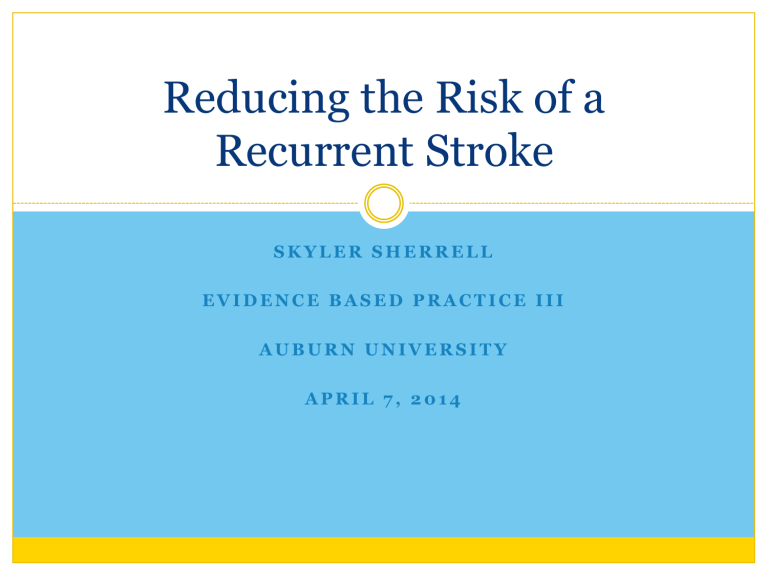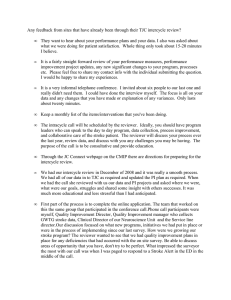
Reducing the Risk of a Recurrent Stroke SKYLER SHERRELL EVIDENCE BASED PRACTICE III AUBURN UNIVERSITY APRIL 7, 2014 Introduction, Background & Significance Introduction: With a continued rise in the number of strokes across the United States each year, it is more important than ever to ensure that nurses caring for these patients are adequately informed related to the newest evidence. Background: The purpose of this small test of change was to determine if the knowledge base of staff nurses in a neuroscience unit was increased after an in-service related to the latest evidence is provided. Because of the increase in knowledge base, the results were analyzed to determine trends or patterns. Significance: Nearly 25% of strokes that occur yearly in the United States are preceded by a CVA or TIA , making it even more important to provide education related to reducing these risks. PICO Question • Target Population: Adult individuals over the age of 18 years old who have suffered from a stroke or TIA. • PICO Question: In adult patients who have been diagnosed with a CVA or TIA, what methods, including medications and lifestyle changes, can be used to decreased the risk of recurrent CVA or TIA? P: Adult patients who have been diagnosed with a CVA or TIA I: Medications and lifestyle changes C: Making these changes or not O: A decrease recurrent CVAs or TIAs T: Does not apply Literature Search & Summary of Evidence • Literature Search: ² ² ² • Auburn Database (CINAHL, MEDLINE (EBSCO, PubMed) American Heart Association Phrases used: “Recurrent stroke,” “prevention,” “medications,” and “lifestyle changes.” Summary of Evidence: ² ² ² ² The risk of recurrence 1 year after initial attack is 8.0% The risk of recurrence is 30%-40% within the first 5 years after original infarct 45%-65% of strokes occur within 30 days of a TIA Risk of death within 1 year after stroke is 24.5% Recommendations ² ² ² ² ² A target blood pressure should be based on each individual patient, but normal levels should be less than or equal to 120/80. (Grade: B) Patients who smoke should be advised to quit smoking and to avoid environmental tobacco smoke. (Grade: C) The healthcare provider can aid in smoking cessation by offering different methods of tobacco replacement. (Level B) Those who are able to engage in physical activity should engage in at least 30 minutes per day. (Grade: C) An anticoagulant or antiplatelet should be prescribed to each patient suffering from an ischemic stroke at discharge. (Grade: A) Small Test of Change • Small test of change: Determining the effectiveness of an in-service on staff nurses of a neuroscience unit to increase education related to post stroke care. • Implementation: Nurses at Baptist Medical Center neuroscience unit were given a verbal in-service, along with pamphlets with education related directly to reducing the risk of a recurrent stroke post discharge. • Evaluation: Nurses were given a pre-test and post-test that were comprised of the same 10 questions. Data was anonymously collected related to the age, gender, and years of experience of the nurse, along with the total score of the pre and post tests. Measurement Tool: Questions 1-5 What modifiable risk factors are related to reducing the risk of a recurrent stroke? ¡ ¡ ¡ What disease process are related to stroke? ¡ ¡ ¡ ¡ ¡ ¡ ¡ Antithromolytic Anticoagulant for Aflutter Statin drug All of the above What is the most common “fall-out” related to BMCS Stroke Core Measures? ¡ ¡ ¡ ¡ Atrial fibrillation Hypertension Diabetes All of the above Patients should receive with of the following medications at or by discharge? ¡ Cigarette smoking Family history of stroke Atrial fibrillation Antithromolytic prescribed at discharge Documentation of use of SCDs only at DVT prophylaxis in patients with hemorrhagic stroke Lack of teaching documentation at discharge No MD signature on core measure What resources does BMCS offer for post-discharge rehabilitation? ¡ ¡ ¡ ¡ Health South rehabilitation Nursing home care Home health care All of the above Measurment Tool: Questions 6-10 Before a patient with residual effects from a stroke is discharged, he or she should be evaluated by: ¡ ¡ ¡ ¡ If okay by the physician, physical activity should be: ¡ ¡ ¡ ¡ ¡ ¡ Reviewing speech therapy notes Asking the patient what he or she prefers Considering the patients comorbidities A&C Reasons that the patient should return to the hospital immediately include: ¡ ¡ ¡ ¡ ¡ 10 minutes per day 5 days a week 30 minutes a day for 4 days a week 2 hours per day 1 day a week To ensure that a proper diet is prescribed at discharge, the nurse is responsible for: ¡ Wound and Ostomy care PT/OT Case manager Both B & C Sudden numbness/weakness in hand, arm or leg Can not feel one side of the face or body Cannot understand what someone is saying Suddenly cannot see out of one eye All of the above At discharge patients should be taught that their target blood pressure should be: ¡ ¡ ¡ ¡ <110/60 <140/90 <130/80 in those with DM and HTN Both B & C Results § § Group 1 (Pre-test Group) § Mean: 8.13 § Median: 9.00 § Mode: 9 § Standard Deviation: 1.885 Group 2: (Post-test Group) § Mean: 9.33 § Median: 9.50 § Mode: 10 § Standard Deviation: 0.816 Summary and Conclusion ÷Conclusion ÷The significance of the intervention is 0.023 when calculated via t-test. ÷Summary ÷Though there were 8 participants in group one and six in group 2, the intervention proved to significant in increasing the knowledge base on neuroscience nurses that were tested. How they Compare Post Test Group Pre Test Group 7.5 8 8.5 9 9.5 Big Idea Increased knowledge base of nurses will prove to beneficial to patients Adequately educating patients will reduce a risk of recurrent stroke Nurses were easily taught References Bergman, D. (2011). Preventing recurrent cerebrovascular events in patients with stroke or transient ischemic attack: The current data. Journal Of The American Academy Of Nurse Practitioners, 23(12), 659-666. doi:10.1111/j.1745-7599.2011.00650.x Dontje, K. (2008). Evidence-Based Practice: Understanding the Process. Advanced Practice Nursing eJournal, 7(4). Feng, W., Hendry, R., & Adams, R. (2010). Risk of recurrent stroke, myocardial infarction, or death in hospitalized stroke patients. Neurology, 74(7), 588-593. doi:10.1212/WNL0b013e3181cff776 Lawrence, M., Fraser, H., Woods, C., & McCall, J. (2011). Secondary prevention of stroke and transient ischemic attack. Nursing Standard, 26(9), 41-46. Lennon, O., Galvin, R., Smith, K., Doody, C., & Blake, C. (2013). Lifestyle interventions for secondary disease prevention in stroke and transient ischaemic attack: a systematic review. European Journal Of Preventive Cardiology. Goldstein, L., Bushnell, C., Adams, R., Appel, L., Braun, L., Chaturvedi, S., & ... Pearson, T. (2011). Guidelines for the primary prevention of stroke: a guideline for healthcare professionals from the American Heart Association/American Stroke Association. Stroke (00392499), 42(2), 517-584. doi:10.1161/STR.0b013e3181fcb238 Sacco, R., Adams, R., Albers, G., Alberts, M., Benavente, O., Furie, K., & … Tomsick, T. (2006) Primary prevention of ischemic stroke: a guideline from the American Heart Association/American Stroke Association Stroke Council: cosponsored by the Atherosclerotic Peripheral Vascular Disease Interdisciplinary Working Group; Cardiovascular Nursing Council; Clinical Cardiology Council; Nutrition, Physical Activity, and Metabolism Council; and the Quality of Care and Outcomes Research Interdisciplinary Working Group: the American Academy of Neurology affirms the value of this guideline. Stroke 37(6): 1583-1633.



